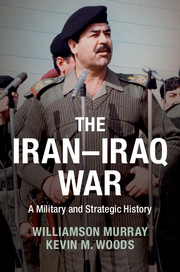Book contents
- Frontmatter
- Dedication
- Contents
- List of figures
- List of tables
- Preface
- Acknowledgments
- Note to reader
- 1 Introduction
- 2 A context of “bitterness and anger”1
- 3 The opponents
- 4 1980: The Iraqi invasion begins
- 5 1981–1982: Stalemate
- 6 Defeat and recovery
- 7 1983–1984: A war of attrition
- 8 1985–1986: Dog days of a long war
- 9 1987–1988: An end in sight?
- 10 Conclusion
- Appendix A Timeline
- Appendix B People
- Appendix C Place names
- Appendix D Order of battle
- Bibliography
- Index
- References
9 - 1987–1988: An end in sight?
Published online by Cambridge University Press: 05 September 2014
- Frontmatter
- Dedication
- Contents
- List of figures
- List of tables
- Preface
- Acknowledgments
- Note to reader
- 1 Introduction
- 2 A context of “bitterness and anger”1
- 3 The opponents
- 4 1980: The Iraqi invasion begins
- 5 1981–1982: Stalemate
- 6 Defeat and recovery
- 7 1983–1984: A war of attrition
- 8 1985–1986: Dog days of a long war
- 9 1987–1988: An end in sight?
- 10 Conclusion
- Appendix A Timeline
- Appendix B People
- Appendix C Place names
- Appendix D Order of battle
- Bibliography
- Index
- References
Summary
So we have to continue to create hoopla that we support this resolution so and so 598. But we should not hurry [in] forging peace, because this [Resolution 598] will not produce peace. [P]eace will be achieved when Iran is incapable … and this Iranian incapacity, God willing, is on its way to being achieved.
– Saddam HusseinThe year 1987 began, as had the previous six years in the war, with no end in sight. Yet within the next year-and-a-half, the outcome on the battlefield – as well as Iran’s almost complete isolation in the world – finally forced Khomeini to agree to a humiliating peace. The international community’s virtual silence after the USS Vincennes shot down an Iranian airliner in July 1988 underlined for the Iranians that they had no worthwhile friends, something even Khomeini could no longer ignore. Battlefield results during 1987–1988 should have been equally clear to the true believers in Tehran. Their great winter offensive of 1987, which had aimed at destroying the Iraqi Army and overthrowing the Ba’athist regime, failed in a welter of blood and chemicals that devastated the attacking troops. In the spring of 1988, Iraq went on the offensive with refurbished forces and inflicted a series of devastating defeats. By July 1988, the Iranian Army was in tatters, approaching collapse that, had the war continued, might have threatened the stability of an Islamic Republic already confronting serious internal difficulties.
A number of factors shaped the character of the war’s final acts. First was the increased sophistication of Iraqi tactical operations. By this point in the war, Saddam was supporting military professionalism over political, tribal, and regional loyalties when choosing his senior commanders. The resulting changes in the high command coupled with hard-earned experience finally began to influence Iraq’s fielded capabilities. The problems the army had run into during the winter 1987 Iranian offensive encouraged Saddam to bestow his trust and responsibility on competent, proven officers.
- Type
- Chapter
- Information
- The Iran–Iraq WarA Military and Strategic History, pp. 286 - 335Publisher: Cambridge University PressPrint publication year: 2014



